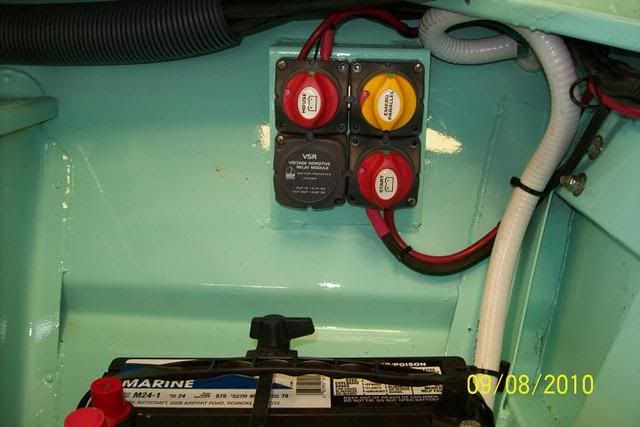i keep gettin a voltage drop in my gps and im trying to stop it from `shutin off when i restart the boat i need to isolate the two batterys upon starting just dont know whats the best way to go with the yamaha isolator wire
Yes The GPS is shutting off because your Spiking it. This happens when you start the motor with GPS ON and the Start battery is shared by the House loads.
This is a typical setup ...But it's Wrong.
You actually do not need the Add a Battery. I prefer the BEP setup, as it is a cleaner setup..... But you don't need that either.
You already have the AUX. Charge wire to charge the House Battery.
What you need is some rewiring with your batteries.
A Perko switch and others like them is really a screwy thing. You have 2 batteries..... So in your mind you have a Start & a House.
But the way the switch is, is that No matter which battery you select.....It's a Start battery because it feeds the motor.
You have to make the Start battery feed the motor and the House battery be independent of the Start and just feed the House.
The AUX. wire from the motor will charge the House battery.
Thats the best I can explain it here.
But this is what the BEP Cluster does. We eliminate the Aux. wire, because the relay decides which battery or batteries get the charge.
BEP Cluster Switch.
You start your day by turning the Start switch and the House switch to ON.
At the end of the day you turn them both OFF.
It doesn't get any simpler than that. You don't have to remember to turn from Batt 1 when going out and switch to Batt 2 on the way back in. Just something else that you have to remember.
OK so what goes on with it is done all automatically thru the VSR [Voltage Sensitive Relay]
The Relay is in a closed position. As soon as you hit the key to crank the motor the relay opens, due to sensing a large surge of current.
Ok the motor is cranked and running now. The relay is still open. The Alt is charging the Start battery until it reaches a set voltage and charge.
Then the relay closes and is back charging Both the Start & House Battery.
Now another feature that happened when you hit the key is your electronics were ON and wired from the House battery. This will stop any spiking of the Electronics. They don't like to be spiked!
OK...Now your out sitting on the beach. The motor is OFF, but you have the Radio playing for hours. The Relay senses the drop and opens the relay again. The radio is still playing, but the relay just disconnected the Start battery out of the circuit so that it stays at Full charge to start the motor.
When you get ready to leave the beach and crank the motor the alt will charge the Start battery first and when it's back up, the relay will close and charge the House battery.
There is one more switch on the Cluster. It is the Combine switch. Think of that as Jumper Cables without having to dig them out and hook them up. This switch would normally be in the OFF position, until you need a boost on the start battery. Then turn it to ON. After the motor is running turn it back OFF.
Everything is all Automatic. No thinking about it. Your batteries will have a much better charge in them.
The unit pictured below is just slightly larger than a Perko switch. So it doesn't take up much room and takes a LOT less room than the Blue Seas version. It looks cleaner too, due to the cables that are needed on the Blue Seas version.





